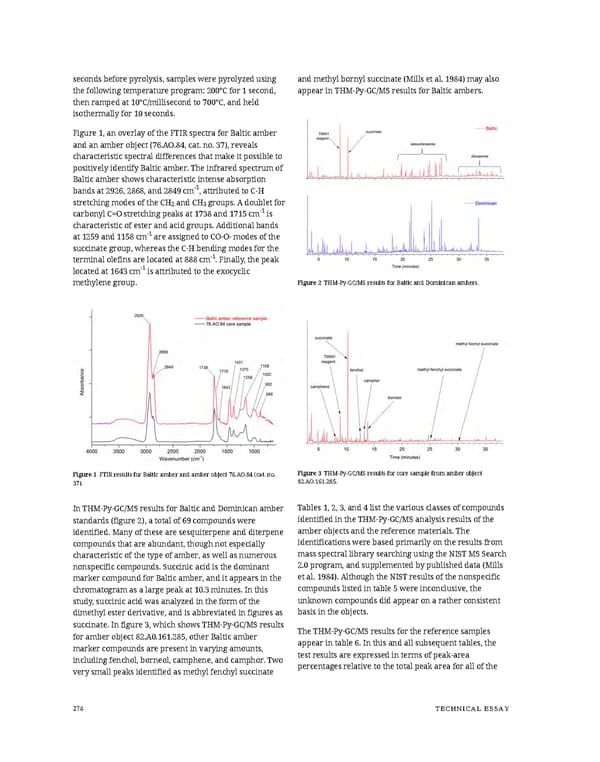seconds before pyrolysis, samples were pyrolyzed using and methyl bornyl succinate (Mills et al. 1984) may also the following temperature program: 200°C for 1 second, appear in THM-Py-GC/MS results for Baltic ambers. then ramped at 10°C/millisecond to 700°C, and held isothermally for 10 seconds. Figure 1, an overlay of the FTIR spectra for Baltic amber and an amber object (76.AO.84, cat. no. 37), reveals characteristic spectral differences that make it possible to positively identify Baltic amber. The infrared spectrum of Baltic amber shows characteristic intense absorption -1 bands at 2926, 2868, and 2849 cm , attributed to C-H stretching modes of the CH2 and CH3 groups. A doublet for carbonyl C=O stretching peaks at 1738 and 1715 cm-1 is characteristic of ester and acid groups. Additional bands at 1259 and 1158 cm-1 are assigned to CO-O- modes of the succinate group, whereas the C-H bending modes for the terminal olefins are located at 888 cm-1. Finally, the peak located at 1643 cm-1 is attributed to the exocyclic methylene group. Figure 2 THM-Py-GC/MS results for Baltic and Dominican ambers. Figure 1 FTIR results for Baltic amber and amber object 76.AO.84 (cat. no. Figure 3 THM-Py-GC/MS results for core sample from amber object 37). 82.AO.161.285. In THM-Py-GC/MS results for Baltic and Dominican amber Tables 1, 2, 3, and 4 list the various classes of compounds standards (figure 2), a total of 69 compounds were identified in the THM-Py-GC/MS analysis results of the identified. Many of these are sesquiterpene and diterpene amber objects and the reference materials. The compounds that are abundant, though not especially identifications were based primarily on the results from characteristic of the type of amber, as well as numerous mass spectral library searching using the NIST MS Search nonspecific compounds. Succinic acid is the dominant 2.0 program, and supplemented by published data (Mills marker compound for Baltic amber, and it appears in the et al. 1984). Although the NIST results of the nonspecific chromatogram as a large peak at 10.3 minutes. In this compounds listed in table 5 were inconclusive, the study, succinic acid was analyzed in the form of the unknown compounds did appear on a rather consistent dimethyl ester derivative, and is abbreviated in figures as basis in the objects. succinate. In figure 3, which shows THM-Py-GC/MS results The THM-Py-GC/MS results for the reference samples for amber object 82.A0.161.285, other Baltic amber appear in table 6. In this and all subsequent tables, the marker compounds are present in varying amounts, test results are expressed in terms of peak-area including fenchol, borneol, camphene, and camphor. Two percentages relative to the total peak area for all of the very small peaks identified as methyl fenchyl succinate 274 TECHNICAL ESSAY
 Ancient Carved Ambers in the J. Paul Getty Museum Page 283 Page 285
Ancient Carved Ambers in the J. Paul Getty Museum Page 283 Page 285